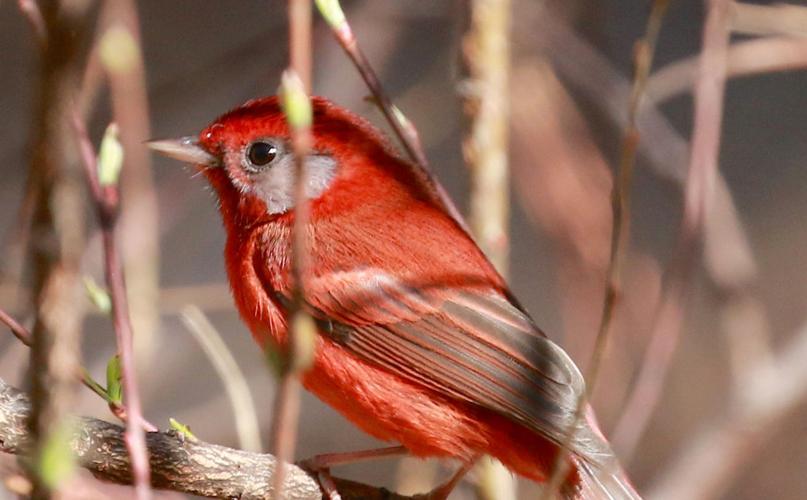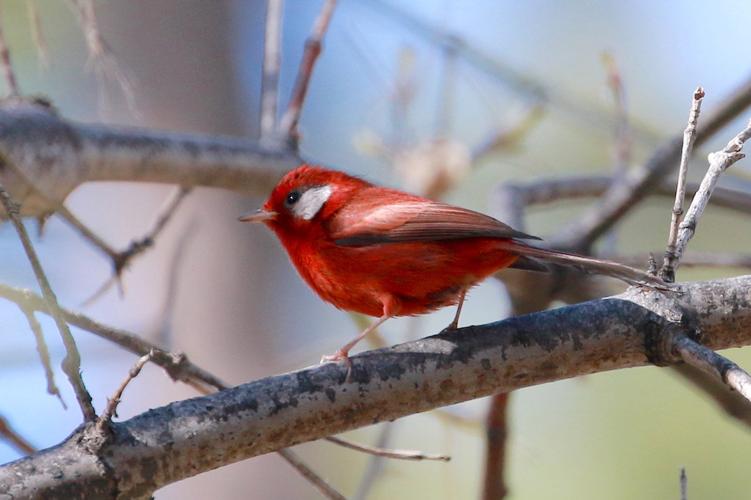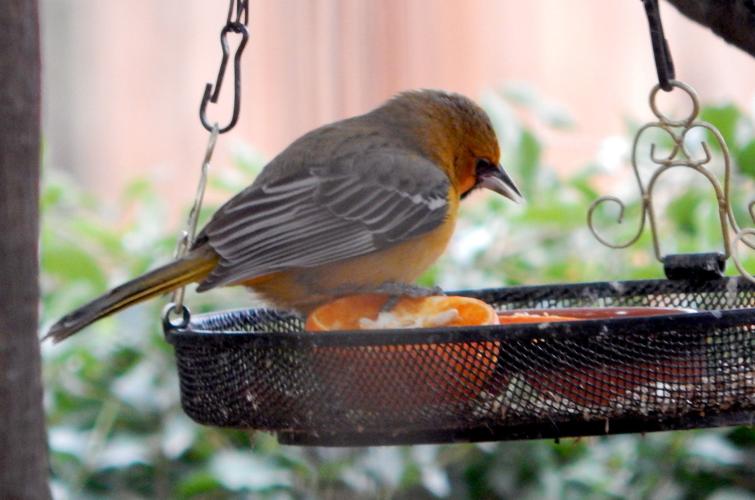It flitted and foraged for insects through a patch of leafless willow trees on Mount Lemmon, putting its strawberry red body and white cheek patch on full display for many hours.
That was the public coming out moment in the U.S. for the red warbler. It’s a 5-inch-long Mexican bird that apparently flew hundreds of miles before coming to rest near Rose Canyon Lake on Monday for its first documented visit to this country. The bird, whose sex couldn’t be determined, was seen by many bird-watchers that day, but hasn’t been seen there since then, although dozens more birders have tried.
It’s one of two Mexican species that have made unprecedented visits to Tucson this year. That continues a yearslong pattern of Mexican birds that may have been drawn into Southern Arizona in increasing numbers by a long-term warming trend.
The other new Tucson arrival is a female streak-backed oriole. Since January, the orange-yellow bird has been regularly seen in a bird feeder and a mesquite tree in side yards of a home in midtown Tucson, near Speedway and Country Club Road.
It was, in fact, spotted again Wednesday morning by Linda Merrick, who has encouraged birders to come to her yard to see it. The bird flies regularly from her street to the site of the closed Benedictine Monastery on 800 N. Country Club Road.
Unlike the red warbler, which typically lives no farther north than southern Chihuahua, the oriole typically lives as far north as northern Sonora and has visited and even bred several times in Arizona before. But it hasn’t been documented in the Tucson area, several local bird experts said.
For Janet Stein, who stumbled upon the red warbler while birding with a friend late Monday morning, the sighting was a huge thrill and a stroke of luck.
“We were just lucky. We were in the right place at the right time,” Stein said.
A Whidbey Island, Washington, resident, Stein had come to Tucson to watch birds. She arranged to drive up to Rose Canyon Lake Monday with Janet Moore, a longtime Tucson bird-watcher whom she had met last May on a birding trip to Cape May, New Jersey. The lake, a popular camping spot in warm weather, lies at about 7,000 feet, 17 miles northeast of Tucson on Mount Lemmon Highway
Their targets were the red-faced and olive warblers, common Santa Catalina Mountains dwellers. They were walking along a narrow creek bed containing intermittent patches of water near an amphitheater, when Stein saw a flash of red, maybe 10 to 20 feet off the ground in open shrubbery.
“It was not high up in the trees, it was down in the lower willows, making it really easy to spot,” Stein said Wednesday. “So many warblers are high up in the trees, but this bird was a lot of times perching within 20 feet of us.
“It was not difficult to see at all. We could easily have stayed there for hours watching it. It wasn’t going anywhere.”
After watching it for 20 to 30 minutes, the two returned to Tucson. Moore contacted a local birding expert she knows, who rounded up a bunch of friends to drive up the mountain and see for themselves.
Late that afternoon, the red warbler’s identity was formally confirmed by David Stejskal, a veteran Tucson bird guide. In May 2016, he became the first birder in the U.S. to spot another Mexican bird — the pine flycatcher. Stejskal photographed it and recorded its voice as it darted from tree to tree in the Santa Rita Mountains.
It was at Aliso Spring, which unlike Rose Canyon is a rarely visited spot in a grove of sycamore and oak trees at about 5,800 feet, lying nearly 10 miles west of Arizona 83 near Gardner Canyon.
As for the warbler, Stejskal said he saw it about five minutes after he and his companions exited their car, in the same little stream right behind the amphitheater that feeds the lake.
“It was foraging at the edge of a tree. The thing that caught my eyes was that it made a big sally to catch an insect. All those trees are just starting to bud out, and it was pretty easy to see the bird inside a leafless tree,” Stejskal said Wednesday.
New discoveries of bird species in the U.S. are rare, occurring maybe twice a year, local bird guide Gary Rosenberg has said.
Besides the pine flycatcher, the elegant trogon, flame-colored tanager, slate-throated redstart, rufous-backed robin, tufted flycatcher and rufous-capped warbler have been seen in Southern Arizona more commonly and in some cases much more commonly in recent times than in the past.
Stejskal, who has a biology degree but isn’t a practicing biologist, said his personal opinion is that these birds are being seen more in Arizona because of climate change triggering milder winters, allowing them to survive on the northern edge of their range.
But at the same time, “You could make the argument there’s just more people out there looking for these things than before the turn of the century. Back in the ’70s and ’80s, there were far fewer bird-watchers here. The more eyes that are out looking,” he said.
Since the warbler lives pretty far south in Mexico, its visit to Mount Lemmon “may be just one of those things,” added Jennie MacFarland, Tucson Audubon Society’s bird conservation biologist.
“There are species that hang out just below the international border I would expect to hang out in Arizona in the near future. But this one was a pretty dramatic leap.”
Regardless of why the warbler made its way to Mount Lemmon, Stein said that to see a bird for the first time in the U.S. was an awesome experience.
“Very unbelievable. It’s probably not going to happen again in my lifetime.”






